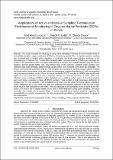| dc.description.abstract | This study evaluated the efficiency of using active sampling to estimate the environmental levels of bioavailable persistent organic pollutants (POPs) by introducing graded filters. Long-term passive sampling was combined with scheduled active sampling in monitoring the levels organochlorine pesticides in the Industrial Area of Nairobi City. Triolein-filled semipermeable membrane devices (SPMDs) were deployed for 28 days in air and surface waters. During the same period, air samples were collected weekly using low-volume samplers, through graded filters, onto polyurethane foam (PUF) sorbents. Similarly water samples were collected using grab sampling, passed through graded filters, and extracted using silica-gel cartridges. The SPMDs were extracted by dialysis while the PUF samplers were extracted in soxhlets, using n-hexane. Cleanup and fractionation was achieved using adsorption chromatography, analytes identified by GC-MS and quantified using the internal standard method. From the results, the levels of OCPs sampled by SPMDs were significantly higher (P ≤ 0.05) than those from active sampling. Further, the standard deviations of DDTs, DDDs and chlordane in air, and those of DDDs, endrin, heptachlor and ��–HCH in surface waters, from active sampling were much larger compared to those of SPMDs samples. These resulted in high percentage coefficients of variance (CV %). The standard errors of differences of means (S.E.D) values for DDTs, DDDs, chlordane, endrin, heptachlor and ��-HCH were very high. This indicated that repeated collection of the two sets of data would result in high variability in the means. This was attributed to the possibility of loss of some of the freephase OCPs due to use of graded filters, and to lack of time-integration during active sampling. This study concluded that though use of graded filters in active sampling could resolve questions regarding the bioavailability the sampled contaminants, the data presented the possibility of underestimation of the levels of the contaminants. | en_US |

